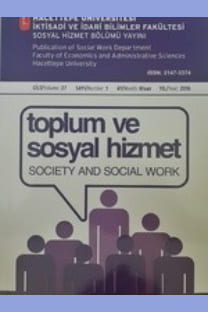ANNE KARNINDAKİ BEBEK SAĞLIK DENETİM ODAĞI (AKBSDO) ÖLÇEĞİ: GÜVENİRLİK VE GEÇERLİK ÇALIŞMASI
Anne karnındaki bebek sağlığı, denetim odağı, tutum, ölçek
Fetal Health Locus of Control Scale: Reliability and Validity Study
Fetal health, locus of control, attitude, scale,
___
- Akköse, K. (2004). Ergenlerin sağlık denetim odağı algılama düzeyleri ve sağlık davranışlarına yansıması (Ankara Kanuni Lisesi Örneği). Ankara Üniversitesi Sağlık Bilimleri Enstitüsü, Sağlık Yönetimi Anabilim Dalı. Basılmamış Yüksek Lisans Tezi.
- Anderson, J.C. ve Gerbing D.W. (1984). The effect of sampling error on convergence, ımproper solutions, and goodness-of-fit ındices for maximum likelihood comfirmatory factor analysis. Psychometrika, 49, 155-173.
- Anderson, J.E., Shahul E., Floyd L., Atrash H. (2006). Prevalence of risk factors for adverse pregnancy outcomes during pregnancy and the preconception period—United States, 2002–2004, Matern Child Health J, 10,101-106. doi:10.1007/s10995-006-0093-z.
- Cole, D.A. (1987). Utility of confirmatory factor analysis ın test validation research. Journal of Consulting and Clinical Psychology, 55, 1019- 1031.
- Cüceloğlu, D. (2007). İnsan ve davranışı- psikolojinin temel kavramları (16.basım). İstanbul: Remzi Kitabevi.
- Dağ, İ. (1991). Rotter’in iç-diş kontrol odağı ölçeğinin üniversite öğrencileri için güvenirliği ve geçerliği, Psikoloji Dergisi, 7 (26), 10-16.
- Hu, L, -T., ve Bentler, P.M. (1999). Cut-off criteria for fit indexes in covariance structure analysis: conventional criteria versus new alternatives. Structural Equation Modeling, 6, 1-55.
- Ip, W.Y., Martin, C.R. (2006). The chinese version of multidimensional health locus of control scale form c in pregnancy, Journal of Psyhosomatic Research, 61, 821-827.
- Johnson, K., Posner, S.F., Biermann J., Cordero, J.F., Atrash, H.K., Parker, C.S., Boulet, S., Curtis, M.G. (2006). Recommendations to improve preconception health and health care --- United States. A Report of the CDC/ATSDR Preconception Care Work Group and the Select Panel on Preconception Care, MMVR, 55(RR06), 1-23.
- Jöreskog, K.G. ve Sörbom, D. (1993). LISREL 8: Structural Equation Modeling With the Simplis Command Language. Hillsdale, NJ: Lawrence Erlbaum Associates Publishers
- Labs, S.M., Wurtele, S.K. (1986). Fetal health locus of control scale: development and validation, Journal of Consulting and Clinical Psychology, 54, 814-819.
- Marsh, H.W. ve Hocevar, D. (1988). A new more powerful approach to multitrait-multimethod analyses: application of second-order confirmatory factor analysis. Journal of Applied Psychology, 73, 107-117.
- Marsh, H.W., Balla, J.R., ve McDonald, R.P. (1988). Goodness-of-fit indexes in confirmatory factor analysis: the effect of sample size. Psychological Bulletin, 103, 391-410.
- McDonald-Miszczak, L., Maki, S.A., Gould O.N. (2000). Self-reported medication adherence and health status in late adulthood: the role of beliefs, Experimental Aging Research, 26, 189-207.
- Rosenstock, I.M., Strecher, V.J., Becker, M.H. (1988). Social learning theory and the health belief model, Health Education Quarterly, 15(2),175-183.
- Simoni, J.M. v Ng, M.T. (2002). Abuse, health locus of control, and perceived health among hivpositive women, Health Psychology, 21, 89-93.
- Tabak, R.S. ve Akköse, K. (2006). Ergenlerin sağlık denetim odağı algılama düzeyleri ve sağlık davranışlarına etkileri, TAF Preventive Medicine Bulletin, 5(2 ),118-130.
- Wallston, K.A., Maides, S., Wallston, B.S. (1976). Health-related information seeking as a function of health related locus of control and health value ,Journal of Research in Personality, 10, 215-222.
- Wallston, K.A., Stein, M.J., Smith, C.A. (1994). Form C of the mhlc scales: A condition-spesific Measure of locus of control, Journal of Personality Assesment, 63 (3), 534-553.
- Wallston, K.J., Wallston, ve DeVellis, R. (1978). Health monographs, 6, 160-170.
- World Health Organization (2011). Country statistics Turkey: Country profiles. maternal, neonatal and child health. Erişim tarihi 7.09.2011 Erişimadresi: http://www.who.int/gho/countries/tur/ country_profiles/en/index.html
- Wulandari, L,P.L. ve Whelan, A.K. (2010). Belifs, attitudes and behaviours of pregnant women in Bali, Midwifery, doi:10.1016/jmidw.2010.09.005
- ISSN: 2147-3374
- Yayın Aralığı: Yılda 4 Sayı
- Başlangıç: 2000
- Yayıncı: Hacettepe Üniversitesi İktisadi ve İdari Bilimler Fakültesi
ÇOCUK YUVALARI VE YETİŞTİRME YURTLARINDA ÇALIŞAN PERSONELİN EMPATİK EĞİLİM DÜZEYLERİNİN İNCELENMESİ
ONKOLOJİ ÇALIŞANLARINDA DOLAYLI TRAVMATİZASYON ÜZERİNE BİR GÖZDEN GEÇİRME
ÖZ-DENETİM ÖLÇEĞİ - ÖDÖ: GÜVENİRLİK VE GEÇERLİK ÇALIŞMASI
Veli DUYAN, Çiğdem GÜLDEN, Selahattin GELBAL
An analysis of the factors affecting the perceived social support among the elderly
Oya HAZER, AYDINER Ayfer BOYLU
ANNE KARNINDAKİ BEBEK SAĞLIK DENETİM ODAĞI (AKBSDO) ÖLÇEĞİ: GÜVENİRLİK VE GEÇERLİK ÇALIŞMASI
Veli DUYAN, Sevgi ÖZCAN, Ayşegül CÖMERT OKUTUCU
SOSYAL HİZMETTE KANITA DAYALI UY GULAMALAR: SOSYAL HİZMET EĞİTİMİ AÇISINDAN İRDELENMESİ
Yasemin ÖZKAN, Elif GÖKÇEARSLAN ÇİFCİ
OKUL ÖNCESİ DÖNEMDE AKRAN ZORBALIĞININ İNCELENMESİ
ORTOPEDİK ENGELLİ KADINLARIN SORUN VE BEKLENTİLERİ ÜZERİNE BİR ARAŞTIRMA: TUZLA İLÇESİ ÖRNEĞİ
